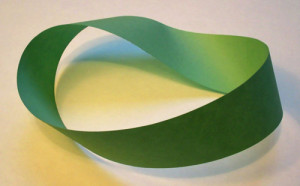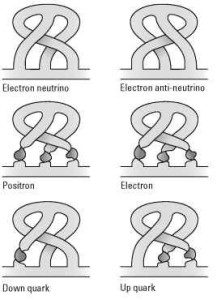Science Seen Physicist and Time One author Colin Gillespie helps you understand your world.
Twist and Shout: Topology In Action
As Chubby Checker sang and showed a 1960s generation, “Let’s do the twist.”
Twist is not only an important thing. It is the only thing. Look around; all that you can see is made of twist. How so? The explanation starts with atoms and takes us through topology and Solitaire to the final fate of the universe.
Throughout history humankind has long looked around and wondered what things are made of. Ancient Greek philosophers conjectured that one could not cut up a chunk of cheese forever. One must, they said, come to a tiny piece that can’t be cut. Atom is Greek for no cut. But atoms were mere fiction for more than two thousand years.
These days chemistry can say which atoms make up any given thing. In nature there are ninety-four kinds of them, from smallest hydrogen to largest plutonium. But they don’t meet Greek specifications. Even before their ordering had settled into the Periodic Table physics seized on atoms and began to cut them up into smaller—and so more fundamental—pieces. As far back as the 1880s scientists were citing lines from Jonathan Swift’s 1733 epic poem: ‘… a flea has smaller fleas that on him prey; and these have smaller still to bite ’em, and so proceed ad infinitum.’ So much for that Greek idea, they said.
Thus the mislabeled modern “atom” was soon cut into a positive nucleus and negative electrons. The electron resisted all assaults but the atom’s nucleus was soon dismantled into positive protons and neutral neutrons. Then by the 1970s both of these (and other “fundamental” particles like mesons) were being chopped up into quarks.
Looking back we see that each new cut began with theoretic speculation. Opening each matrioshka doll to find a smaller doll within we naturally ask: Is there another one inside it?
Indeed, although quarks seem to behave like point particles and the Standard Model regards quarks as fundamental, speculation soon resumed. Could the six kinds of quarks be made of fewer kinds of smaller and more fundamental particles called preons? Smashing protons hard enough to catch a fleeting glimpse of quarks is so difficult that few think we’ll see preons soon.
But theorists are still seeking even smaller, maybe simpler, more fundamental particles. And in 2008 a little-noticed paper by a topologist at the Perimeter Institute in Waterloo proposed a remarkably small, simple and fundamental new entity. Topology is the study of shapes. Sundance Bilson-Thompson says that not only quarks but all known particles may be neatly made of just one fundamental sub-sub-sub-sub-subatomic entity. He calls it a tweedle. It is a twist, which he identifies with electric charge. It can be either a right- or left-handed twist; thus positive or negative charge. Note these are the only choices. And it’s hard to see how they can be made of smaller entities. Has Bilson-Thompson opened up the final matrioshka? Has he found the last level of Swift’s fleas? I think this may be so. His foray into Planck-scale physics may soon become the biggest Nobel event ever.
His work leads to the insight that, as space and matter fizzed smoothly into existence (no Bang; sorry), it made a tangled mess of twists and knots that since then has been doing its best to untangle. Thus all the things we see may be made out of knots in Nature’s knitting.
It’s not widely known that Solitaire card games―most any version―are all about topology. Each card deal represents a set of twists in ordered suits the player sets out to untangle. Some Solitaires such as FreeCell can always (except maybe game 11982) be untangled. Others—the four-suit game of Spider is one—sometimes end in knots with any strategy.
The ultimate question is: Which kind of tangle is our universe? Will all its matter twists untangle in quadrillions of years and leave only far-red photons; and do all the photons also die (as my Time One narrator imagines)? Or does some remnant remain forever?
Closer to home a distantly related question is: What’s the max fraction of Microsoft four-suit Spider deals that can be untwisted?
[Postscript: I set my sights on 80% after 1000 or more games but I’m stuck at 78.7%. Better records sent to info@timeone.ca will be posted on the TimeOneTheBook Facebook page for its 166,000 followers.]
Image credits
Tatyana Gordeeva; http://www.germanculture.com.ua/library/weekly/mobius-strip.html
Sundance Bilson-Thompson; http://what-when-how.com/string-theory/taking-the-loop-introducing-another-road-to-quantum-gravity-string-theory/



No comments yet.